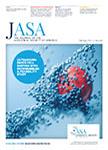版权所有:内蒙古大学图书馆 技术提供:维普资讯• 智图
内蒙古自治区呼和浩特市赛罕区大学西街235号 邮编: 010021

作者机构:University of Nottingham School Electrical and Electronic Engineering University Park NG7 2RD Nottingham UK richard.j.smith@nottingham.ac.uk University of Nottingham School Electrical and Electronic Engineering University Park NG7 2RD Nottingham UK mike.somekh@nottingham.ac.uk University of Nottingham School Electrical and Electronic Engineering University Park NG7 2RD Nottingham UK steve.sharples@nottingham.ac.uk University of Nottingham School Electrical and Electronic Engineering University Park NG7 2RD Nottingham UK roger.light@nottingham.ac.uk University of Nottingham School Electrical and Electronic Engineering University Park NG7 2RD Nottingham UK Nicholas.Johnston@nottingham.ac.uk University of Nottingham School Electrical and Electronic Engineering University Park NG7 2RD Nottingham UK mark.pitter@nottingham.ac.uk
出 版 物:《The Journal of the Acoustical Society of America》
年 卷 期:2008年第123卷第5_SUPPLEMENT期
页 面:3553-3553页
学科分类:07[理学] 082403[工学-水声工程] 08[工学] 070206[理学-声学] 0824[工学-船舶与海洋工程] 0702[理学-物理学]
摘 要:Picosecond laser ultrasonics is a powerful technique for measurement and diagnosis of micro‐ and nano‐scale structures. Unfortunately the data acquisition speeds are slow, this is a major drawback for widespread acceptance and usually makes imaging impractical. We are engaged in a program to accelerate the data capture rate by parallel acquisition of the incoming signals. This involves electronic developments as well as optical design. In order to parallelise the electronics we have used two approaches (i) a modified commercial camera and (ii) a custom built CMOS array detector. These approaches use an integrating camera which by application of suitable algorithms can perform the task of parallel lock in detection. Modulation depths below 1 part in 106, over 512 pixels can be readily detected with the commercial detector and smaller modulation depths are possible with the custom detector on account of the large well depth and hence high signal to noise. We also discuss the novel optical detection configurations that allow parallel detection of ultrasonic waves with ultrasonic wavelengths below the optical diffraction limit. Results are presented that show image acquisition rates orders of magnitude faster than normally possible with picosecond ultrasonic systems. Prospects for ultrahigh resolution optical resolution are discussed.